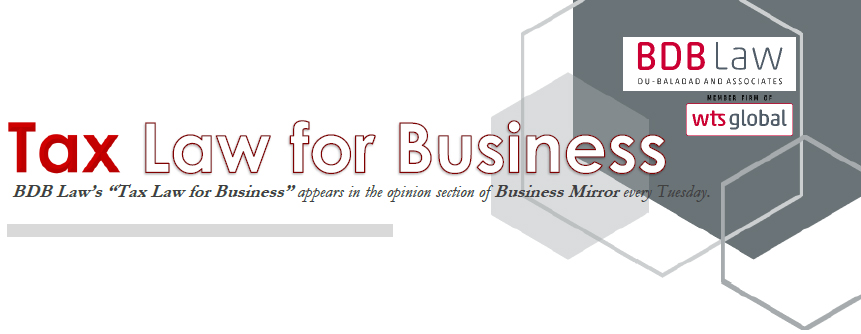
PILLAR TWO: Where Are We Now?
By: Atty. Jomel N. Manaig
"While it is certainly within the competence of the BIR to impose rules and regulations for the effective administration and collection of taxes, it seems that the rules and regulations governing the basic understanding and rudimentary tenets of withholding taxes are now changing and evolving. RR No. 16-2023 is proof of that."
 Atty. Jomel N. Manaig +632 8403-2001 loc. 140 |
A little more than a year ago in my article “OECD’s Pillar Two and the Tax Incentives in the Philippines,” we took a peek at what Pillar Two, or the global minimum corporate tax, is all about and how it can affect domestic subsidiaries of multinational entities.
From then on, we have made some progress in amending our tax laws. For better or for worse, none of these even comes close to touching Pillar Two. However, all that may soon change.
Last October 2023, it was announced that the Philippines joined the OECD/G20 Inclusive Framework on Base Erosion and Profit Shifting (BEPS). It means that the country will be participating in the implementation of the BEPS measures which include Pillar Two.
 Actual implementation by the Philippines of Pillar Two may be for a while if we will consider the pace of our recent tax law amendments as a yardstick. Nonetheless, due to the extraterritorial nature of Pillar Two, domestic corporations with parents in foreign countries may already be affected by Pillar Two notwithstanding the lack of actual implementation by our very own tax authorities.
Actual implementation by the Philippines of Pillar Two may be for a while if we will consider the pace of our recent tax law amendments as a yardstick. Nonetheless, due to the extraterritorial nature of Pillar Two, domestic corporations with parents in foreign countries may already be affected by Pillar Two notwithstanding the lack of actual implementation by our very own tax authorities.
Among our biggest foreign investors, Japan, Singapore, and the United Kingdom already have various implementation dates for Pillar Two. On the other hand, other ASEAN members like Indonesia, Malaysia, and Thailand have also joined the bandwagon and have made announcements on their respective plans and dates of implementation of Pillar Two.
With several countries already eyeing the implementation of Pillar Two by 2024, are our domestic corporations ready? What are some of the practical concerns that must be considered?
For one, corporations must thoroughly familiarize themselves with Pillar Two and its components. This is because Pillar Two is not as simple as imposing the global minimum corporate tax of 15%. Far from it. Pillar Two is actually composed of several independent model rules that work together to effectively impose the global minimum corporate tax.
These rules include the “Income Inclusion Rule” wherein the global minimum corporate tax is paid at the level of the parent entity in proportion to its ownership interests in those entities that have low taxed income. Another rule is the “Undertaxed Payments Rule” wherein a taxpayer who is a member of a multinational group is allowed to make an adjustment in respect of any top-up tax that is allocated to that taxpayer from a low-tax constituent entity of the same group. Lastly, the Qualified Domestic Minimum Top-up Tax Rule allows for the imposition of a domestic minimum tax that applies to local constituent entities of covered multinational entities and produces outcomes that are consistent with the Global Anti-Base Erosion rules.
That is a lot to take in, I know. And that is why domestic entities must start educating their officers and personnel. Pillar Two is a complicated subject and it cannot be taught and understood overnight.
Another practical concern that domestic corporations must face is the actual computation of the jurisdictional excess profit. If a domestic corporation has a foreign parent that is subject to Pillar Two, that foreign entity would most likely require the domestic corporation to compute its jurisdictional excess profit. The foreign parent would then use this data to compute for any top-up tax.
While the computation may be subject to a threshold for error, accuracy is still a paramount consideration. How can one be accurate in computing the jurisdictional excess profit if he/she does not know how to compute it in the first place?
Domestic corporations should start thinking about their plans to cope with Pillar Two requirements. Whether they consult their foreign parents for guidance or start planning on their own, the time to act is now.
The author is a junior partner of Du-Baladad and Associates Law Offices (BDB Law), a member-firm of WTS Global.
The article is for general information only and is not intended, nor should be construed as a substitute for tax, legal or financial advice on any specific matter. Applicability of this article to any actual or particular tax or legal issue should be supported therefore by a professional study or advice. If you have any comments or questions concerning the article, you may e-mail the author at This email address is being protected from spambots. You need JavaScript enabled to view it. or call 8403-2001 local 380.



